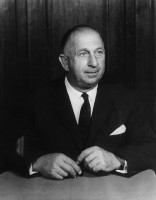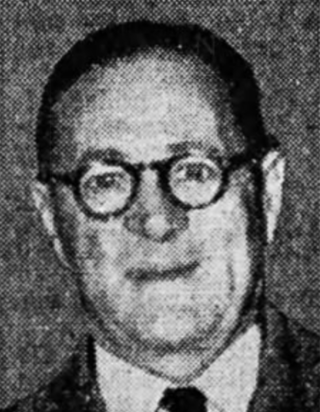
The Nationalist Party, also known as the National Party, was an Australian political party. It was formed in February 1917 from a merger between the Liberal Party and the National Labor Party, the latter formed by Prime Minister Billy Hughes and his supporters after the 1916 Labor Party split over World War I conscription. The Nationalist Party was established as a 'united' non-Labor opposition that had remained a political trend once the Labor party established itself in federal politics. The party was in government until electoral defeat in 1929. From that time it was the main opposition to the Labor Party until it merged with pro-Joseph Lyons Labor defectors to form the United Australia Party (UAP) in 1931. The party is a direct ancestor of the Liberal Party of Australia, the main centre-right party in Australia.

Sir Henry Edward Bolte GCMG was an Australian politician who served as the 38th Premier of Victoria. To date he is the longest-serving Victorian premier, having been in office for over 17 consecutive years.

The Liberal–National Coalition, commonly known simply as the Coalition or the LNP, is an alliance of centre-right political parties that forms one of the two major groupings in Australian federal politics. The two partners in the Coalition are the Liberal Party of Australia and the National Party of Australia. Its main opponent is the Australian Labor Party (ALP); the two forces are often regarded as operating in a two-party system. The Coalition was last in government from the 2013 federal election until the 2022 Australian federal election. The group is led by Peter Dutton, who succeeded Scott Morrison after the 2022 Australian federal election.

John Cain was an Australian politician, who became the 34th premier of Victoria, and was the first Labor Party leader to win a majority in the Victorian Legislative Assembly. He is the only premier of Victoria to date whose son has also served as premier.
Ian Macfarlan was the Deputy Leader of the Australian Liberal Party in the Australian state of Victoria during 1945. He was briefly commissioned as the 35th Premier of Victoria by the Governor and formed a government which brought about the end of the Dunstan Ministry.

Sir Albert Arthur Dunstan, KCMG was an Australian politician. A member of the Country Party, Dunstan was the 33rd premier of Victoria. His term as premier was the second-longest in the state's history, behind Sir Henry Bolte. Dunstan, who was premier from 2 April 1935 to 14 September 1943, and again from 18 September 1943 to 2 October 1945, was the first premier of Victoria to hold that office as a position in its own right, and not just an additional duty taken up by the Treasurer, Attorney-General or Chief Secretary.

Thomas Tuke Hollway was the 36th Premier of Victoria, and the first to be born in the 20th century. He held office from 1947 to 1950, and again for a short period in 1952. He was originally a member and the leader of the United Australia Party (UAP) in Victoria, and was the inaugural leader of the UAP's successor, the Victorian division of the Liberal Party, but split from the Liberals after a dispute over electoral reform issues.

Trevor Donald Oldham was an Australian politician, who was the leader of the Liberal Party in the state of Victoria from 1952 until his death in 1953. The eldest of three sons born to Arthur and Ethel Oldham, he was educated at Melbourne Church of England Grammar School and the University of Melbourne. He had enlisted in the Australian Imperial Force on 7 November 1918, four days before the Armistice.

Elections were held in the Australian state of Victoria on 27 June 1964 to elect the 66 members of the state's Legislative Assembly and 17 members of the 34-member Legislative Council. The Liberal and Country Party (LCP) government of Premier Henry Bolte won a fourth term in office.
The Second Hollway Ministry was the 56th ministry of the Government of Victoria. It was led by the Premier of Victoria, Thomas Hollway and Deputy Premier Alexander Dennett. Hollway and the rest of the ministry were not aligned to a political party at the time, although they would later form the Electoral Reform League to contest the December 1952 election, and had been recently expelled from the parliamentary Liberal and Country Party. With the help of two Hollway supporters in the Victorian Legislative Council, the Labor Party blocked supply to John McDonald's Country Party government, and indicated that they would support Hollway as Premier.

The 1955 Victorian state election was held in the Australian state of Victoria on Saturday 28 May 1955 to elect 65 members of the state's Legislative Assembly.

The 1950 Victorian state election was held in the Australian state of Victoria on Saturday 13 May 1950 to elect 65 members of the state's Legislative Assembly.

The 1943 Victorian state election was held in the Australian state of Victoria on Saturday 12 June 1943 to elect 65 members of the state's Legislative Assembly.

Major Sir Thomas Karran Maltby was a politician in Victoria, Australia. He was a member of the Victorian Legislative Assembly for nearly 32 years from 1929 to 1961, served in several ministries and was Speaker of the assembly from 1947 to 1950.

John Pesutto is an Australian politician and lawyer serving as the Leader of the Opposition in Victoria, holding office as the leader of the Victorian Branch of the Liberal Party of Australia. He has been a member of the Legislative Assembly (MLA) for the inner-city division of Hawthorn since 2022, and previously from 2014 to 2018.
The National Party of Australia – Victoria is a political party in Victoria, which forms the state branch of the federal Nationals. It represents graziers, farmers, miners and rural voters.
William Roy Dawnay-Mould was an English-born Australian politician.
The Victorian Labor Party, officially known as the Australian Labor Party (Victorian Branch) and commonly referred to simply as Victorian Labor, is the semi-autonomous Victorian branch of the Australian Labor Party (ALP). The Victorian branch comprises two major wings: the parliamentary wing and the organisational wing. The parliamentary wing comprising all elected party members in the Legislative Assembly and Legislative Council, which when they meet collectively constitute the party caucus. The parliamentary leader is elected from and by the caucus, and party factions have a strong influence in the election of the leader. The leader's position is dependent on the continuing support of the caucus (and party factions) and the leader may be deposed by failing to win a vote of confidence of parliamentary members. By convention, the premier sits in the Legislative Assembly, and is the leader of the party controlling a majority in that house. The party leader also typically is a member of the Assembly, though this is not a strict party constitutional requirement.

The 2026 Victorian state election is expected to be held on 28 November 2026 to elect the 61st Parliament of Victoria. All 88 seats in the Legislative Assembly and all 40 seats in the Legislative Council will be up for election, presuming there are no new electorates added in a redistribution.
The 2022 Liberal Party of Australia leadership election was an election to appoint the leader of the Victorian branch of the Liberal Party and Leader of the Opposition after the 2022 Victorian state election. Matthew Guy, who had held these roles since September 2021 and previously in 2018 resigned after the Coalition's defeat to the Australian Labor Party at the November election.



























